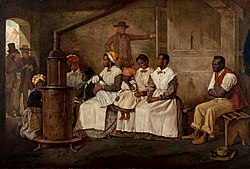
Eyre Crowe ARA (3 October 1824- 12 December 1910), was a British painter and author, principally of historical art and genre scenes, but with an interest in social realism during the mid to late 19th century. [1] His work usually centered around the everyday life's of the poor urban working class during the industrial revolution. [1] [2] [3] He was rather progressive for the time, deviating from the idealistic depictions of urban life popular among the public. [2] [4] Instead he aimed for social realism in his pieces. The 1874 edition of The Art Journal "[un]afraid of reality, and [un]shrinking from scenes that less robust minds would consider vulgar." [3] He died on the 12th of December 1910 from Heart failure following a hernia operation. He is buried in Kensal Green Cemetery, London.

